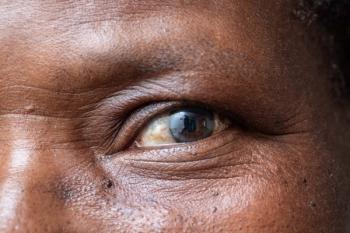
Difluprednate is noninferior to prednisolone, data show
Difluprednate ophthalmic emulsion 0.05% (Durezol, Sirion Therapeutics) was comparable with prednisolone ophthalmic suspension 1% (Pred Forte, Allergan), the current standard of care, in a pivotal anterior uveitis trial. Difluprednate was dosed four times daily compared with eight times for prednisolone acetate, suggesting that it could enhance compliance.
Key Points
The objective of the study was to compare the efficacy and safety of difluprednate with prednisolone in subjects with endogenous anterior uveitis. Difluprednate is FDA-approved for postoperative eye inflammation and pain; its use in this study was off-label, although Sirion plans to use the data to support a supplemental New Drug Application.
"[Difluprednate] was at least as good if not better than the standard of care, prednisolone, on all scores," said Dr. Foster, an investigator in the trial. "There's no question that it represents a major advance."
The multicenter, randomized, double-masked phase III trial was conducted at 20 sites in the United States and completed in September 2008. The study was designed to show noninferiority and was not powered to show statistical superiority of one treatment over the other. The primary endpoint was the between-group difference from baseline in anterior chamber cell grades on day 14.
The test drugs were administered for 14 days, followed by 2 weeks of tapering at reduced dosing frequencies and two additional weeks of follow-up during which tapering was continued at the investigators' discretion.
The inclusion criteria included a diagnosis of noninfectious anterior uveitis in at least one eye and an anterior chamber cell grade ≥2 (more than 10 cells per high-powered field) and a flare score ≥2 (more than moderate) in the same eye.
The study population consisted of 90 subjects, 50 randomly assigned to difluprednate and 40 to prednisolone. In the difluprednate group, the mean age was 47 years and the cohort was 46% male. In the prednisolone group, the mean age was 43 years, and 37.5% of the subjects were male. The majority of subjects in both groups were Caucasian.
The results for the primary endpoint confirmed the noninferiority of difluprednate, Dr. Foster said. On day 14, the mean cell grade reduction in the difluprednate group was 2.1 versus 1.9 in the prednisolone group. The percent of subjects with clearing of anterior chamber cells at day 14 was 68.8% in the difluprednate group and 61.5% in the prednisolone group.
Patients in the difluprednate group had a greater reduction in mean pain score from baseline at four of five time points in the study. At day 3, subjects in the difluprednate group had a 58% reduction in pain score compared with 51% in the prednisolone group. The difluprednate group also had a higher percentage reduction at day 7 (71% versus 64%), day 21 (89% versus 79%), and day 28 (86% versus 84%). At day 14, patients in the prednisolone group had a greater percent reduction, 80% versus 77% in the difluprednate group.
At all time points assessed, difluprednate was superior to prednisolone in the change from baseline in mean score for photophobia.
The safety findings showed that a clinically significant increase in IOP was infrequent in both study groups. Three subjects (6%) in the difluprednate group and two subjects (5%) in the prednisolone group met the criterion, which was an observed value ≥21 mm Hg and a change from baseline ≥10 mm Hg. All of the IOP increases either were controlled with medication or did not require treatment.
No drug-related serious adverse events occurred in the trial. The rate of other adverse events was similar in both groups (difluprednate, 68%; prednisolone, 70%), and most were mild or moderate in intensity. The most frequent treatment-related ocular adverse events, occurring in ≥5% of subjects in both groups, were punctate keratitis, eye irritation, blurred vision, anterior chamber inflammation, and dry eye.
In all, five patients (12.5%) in the prednisolone group withdrew from the study due to lack of efficacy or adverse events associated with worsening uveitis symptoms; none withdrew in the difluprednate group. This finding was statistically significant (p = 0.0101).
Newsletter
Don’t miss out—get Ophthalmology Times updates on the latest clinical advancements and expert interviews, straight to your inbox.



















































.png)


